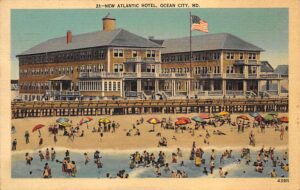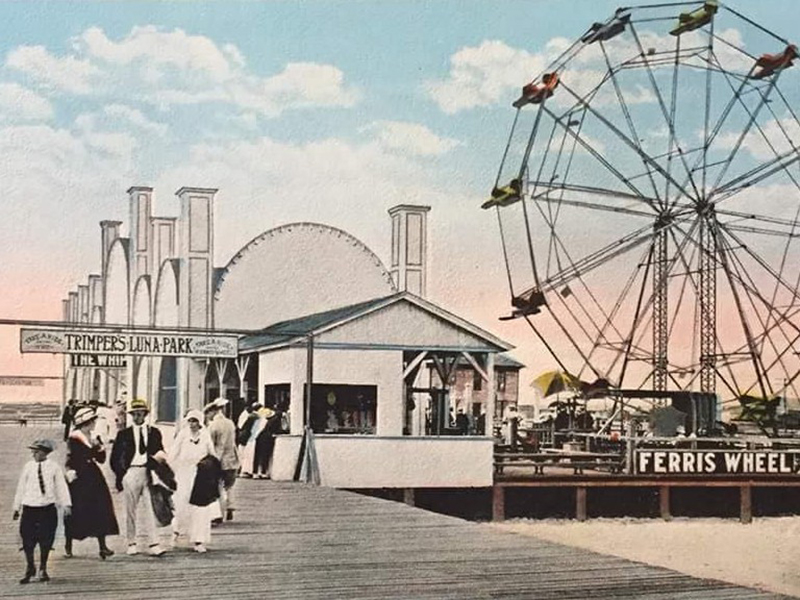Is it summer in Maryland if you didn’t head downy ocean, hon?
Ocean City’s History and Unique Historic Sites
The land on which Ocean City was established was acquired by Englishman Thomas Fenwick as a land grant from Lord Baltimore; the land was previously used for centuries by Algonquian tribes in the area. Small structures were built on the barrier island beach as early as 1839, but at that time the town was only accessible by stage coach and ferry. It was a popular spot for summer excursions for the local residents of mainland Worcester County and in 1867 the city was officially patented as the “Lady’s Resort to the Ocean.”
In 1869, businessman Isaac Coffin saw tourism potential in the city and built the first beach-front cottage that would receive paying guests. Others followed suit and soon there were several small boarding houses lining the beach. The post-Civil War era brought the railroad to the beach in 1868 and the announcement that the east/west rail lines would stretch from Salisbury to Berlin and across the Sinepuxent Bay to the barrier island, therefore making the beach more accessible, prompted the Atlantic Company to begin building hotels. The Atlantic Hotel Company committee chose to call the new resort town “Ocean City.” On July 4, 1875 the Atlantic Hotel opened its doors. By 1878 tourists began to travel by rail to Ocean City and in 1881 the rail line bringing passengers directly to the shore was completed. The Congress Hall and Seaside hotels followed suit and opened during this tourism boom.
WEATHERING NATURAL DISASTERS
In the decades that followed, Ocean City experienced several disasters that changed the built landscape. 1889 saw a storm that destroyed cottages, washed away much of the Congress Hall hotel, and tore the porches off of the Atlantic Hotel. The Great Ocean City Fire in 1925 destroyed the pier and three blocks of old downtown Ocean City. The Atlantic and Seaside Hotels were lost, as well as two blocks of the Boardwalk, which had been first constructed on a smaller scale in 1902, Dolle’s Candyland, the Casino Theater, and the C.W. Purnell Cottage. The Atlantic Hotel was rebuilt a year later.

In 1933, a major hurricane swept through Ocean City creating the inlet and destroying the railroad tracks that had made Ocean City such an immensely popular tourist destination. The Army Corps of Engineers made the inlet permanent, which resulted in Ocean City becoming an important Atlantic fishing port. The Baltimore Sun called the Great Storm of 1962 the “Storm of the Century.” The massive destruction led to rapid expansion and turned Ocean City into the vacation destination as we know it today. Finally, a fire destroyed the original Ocean City pier in 1994.
Ocean City’s susceptibility to natural disasters, unpredictable weather, and human error mean that the landscape is frequently changing and the preservation of historic structures is all the more difficult. The historic Atlantic Hotel is still operational since its rebuild in 1926 and has been owned by the same family since 1923. There are several other hotels and buildings that have managed to survive for nearly 100 years, but very few structures from Ocean City’s founding remain.
OCEAN CITY HERITAGE TOURISM TIPS
While you’re soaking up a Maryland summer, take a moment to stop by one of Ocean City’s historic buildings:
- City Hall, visit to view the historic photographs on display, 301 Baltimore Avenue
- Ocean City Life-Saving Station Museum, first built in 1891, 813 S. Atlantic Avenue
- St. Paul’s by the Sea Episcopal Church, constructed in 1900 and listed on the National Register of Historic Places, 302 N. Baltimore Street
- The Atlantic Hotel, the first hotel built in Ocean City in 1875, rebuilt in 1926, Oceanfront at Boardwalk & Wicomico
- The Lankford Hotel, built in 1924, 807 N. Atlantic Avenue
- Walking Tour, take a walking tour of Historic Downtown Ocean City, brochures at the Information Cottage on the Boardwalk between North Division and Caroline Streets

